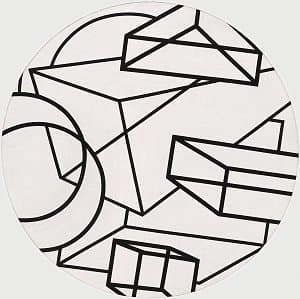

Al Held
Learn moreSkywatch II 1971
© Al Held. VAGA/Copyright Agency Purchased 1973
More detail | PermalinkAl Held, like so many artists of his generation, was heavily influenced by Abstract Expressionism. In the 1950s he worked in a gestural manner but then began to introduce geometric shapes with clean edges and flat colour. These elements became the hallmarks of his mature style, which gained him critical acclaim from the 1960s onwards.
Skywatch II 1971 belongs to a distinctive phase of Held’s career during which he developed a vocabulary of lines, outlined shapes and transparent forms that conjure a series of spatial ambiguities within the picture. In his monograph on the artist, Irving Sandler labelled these works ‘ambistructural’ abstractions,[1] suggestive of the way the transparent ‘structures’ appear to project and recede from the picture surface in a constant state of flux. Another feature of Held’s paintings during this period was that he worked exclusively in black and white; first black lines on a white background as in Skywatch II, later white lines on a black background. Held instigated this reductive palette in 1967 as he felt that colour was superfluous to his investigations and would make no more than a decorative addition.
Skywatch II, along with a slightly smaller companion painting, Skywatch I 1972[2], are painted on circular canvases, making them unique in Held’s oeuvre. In Skywatch II the rectangular and triangular prisms seem to float within an illusionary and implausible space, while the circular, nearly cylindrical forms echo the shape of the painting. The relationship established between the internal elements and the canvas support seems to concede the painting’s status as an object, giving an almost sculptural quality.
Paintings exhibited in the artist’s solo show at the André Emmerich Gallery, New York, in 1972 presented challenges to the major preoccupations of American painting during the 1960s. This is evident in the different interpretative approaches taken by critics in response to the exhibition. Sandler commented:
The spatial ambiguity (more than the suggested volumes and voids) serves to completely disintegrate the picture plane─by eliminating fixed reference points in relation to which the components might be measured. Thus Held creates a total illusionism; his painting is essentially an indeterminate, deep hollowing and billowing space in which geometric elements float freely.[3]
In another review, Kenneth Baker attempted to reconcile Held’s illusionistic spaces with the modernist preoccupation with the flatness of the picture surface, concluding:
The most interesting thing about the pictures may be that they are organized in such a way as constantly to call attention to the common existence of the picture plane and the literal surface. What one realises after a while is that the transparency of the ‘open’ figures is the transparency of the picture plane. And in these paintings that transparency always connects with an ambiguity which affirms the opacity of the literal surface as the ultimate condition which makes every pictorial incident possible.[4]
While the works of the Skywatch series are the artist’s only ‘shaped’ canvases, the motifs within these paintings, particularly the overlapping double-circle in the lower-left quadrant of Skywatch II and the oblique ring in Skywatch I, are visual devices often used by Held throughout the 1970s.
Steven Tonkin
[1] Irving Sandler, Al Held, Hudson Hills Press, New York, 1984, p 65; Sandler identified ‘distinct’ phases in Held’s oeuvre, labelling the artist’s preceding paintings from the late 1950s as ‘pigment paintings’ and his work of the early to mid 1960s as ‘concrete abstractions’.
[2] Akron Art Museum, Ohio.
[3] Irving Sandler, ‘Al Held at Emmerich, Philip Pearlstein at Frumkin’, Art in America, vol 60, no 5, September–October 1972, p 114.
[4] Kenneth Baker, ‘Al Held, Emmerich Galleries, uptown and downtown’, Artforum, vol 10, no 10, June 1972, p 87.

